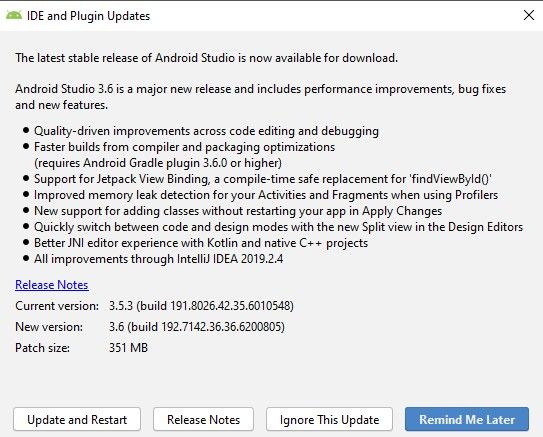
Google released version 3.5 of its IDE for Android app development, Android Studio, to the stable channel in the middle of last year. That release was the culmination of months of bug fixes and stability improvements. Today, Google announced that the next stable release, Android Studio 3.6, is now available to developers. The update has been in testing for months, and it focuses on improving the experience of code editing and debugging. Here’s an overview of what’s new in the latest release.
Split View in Design Editors
A new Split View for the Layout Editor and Navigation Editor makes it possible to see the design and code views of your UI simultaneously. Split View replaces the Preview window and can be configured on a file-by-file basis to save contextual information like the zoom level and design view options. To enable Split View, click the “Split” icon in the top right-hand corner of the editor window.
Color picker resource tab
Google has added a “resources” tab to the color picker in Android Studio 3.6. This tab surfaces the colors you defined as color resources to make it easier to choose or edit them. It’s accessible in design tools and the XML editor.
Android Emulator – Google Maps UI
The latest version of the Android Emulator is 29.2.12, and it includes a way to visualize the emulated device location. Google embedded a Google Maps UI in the extended controls menu so developers can specify virtual locations and construct virtual routes.
Multi-display support
Emulator 29.1.10 adds initial support for showing multiple virtual displays in order to facilitate app development for devices with multiple displays. Developers can configure multi-virtual displays in the Android Studio Emulator through the Settings menu (Extended Controls > Settings).


Other changes
- View binding: Incompatibilities between your XML layout files and your code can result in your build failing at runtime. To prevent this, Google is introducing view binding, a feature that, when enabled by adding a single line in each module’s build.gradle file, “generates a binding class for each XML layout file present in that module.” View binding is intended to replace findViewById, allowing you to reference all views with IDs without running into null pointer or class cast exceptions. Learn more about this feature here.
- Android NDK updates: Google has brought Kotlin support for two Android NDK features that were previously supported in Java. They include “[navigation] from a JNI declaration to the corresponding implementation function in C/C++” and “automatically [creating] a stub implementation function for a JNI declaration.”
- IntelliJ Platform Update: IntelliJ 2019.2 is included in Android Studio 3.6. This JetBrains blog post explains the major changes.
- Add classes with apply changes: Clicking either “Apply Code Changes” or “Apply Changes and Restart Activity” will allow you to add a class then deploy that code change to a running app. The difference between these two actions is explained here.
- Android Gradle Plugin updates: Version 3.6 of the Android Gradle plugin adds support for the Maven Publish Gradle plugin. Learn more here.
- In-place updates for imported APKs: Android Studio 3.6 now automatically detects changes to imported APKs and allows you to re-import them in-place so you don’t have to reattach symbols and sources.
- Attach Kotlin sources to imported APKs: You can now attach Kotlin source files to imported APKs. Learn more here.
- Leak detection in Memory Profiler: Google has updated the Memory Profiler with the ability to detect Activity and Fragment instances that may have leaked. The documentation for this feature is available here.
- Deobfuscate class and method bytecode in APK Analyzer: When inspecting DEX files using APK Analyzer, it is now possible to deobfuscate class and method bytecode by loading the ProGuard mappings file for the APK you’re analyzing. More info here.
Google also published a YouTube video summarizing the changes in Android Studio 3.6:
You can download the latest stable release from within Android Studio or from Google’s website. For more details, check out Google’s blog post on the Android Developers Blog or the latest Android Studio release notes. The next major update to the IDE will arrive as Android Studio 4.0, which introduces new Jetpack libraries including CameraX and Compose. Version 4.0 is currently in Canary, so it’ll take a few months before it’s ready for a stable release.
The post Android Studio 3.6 Stable announced with Split View in design editors, Google Maps in emulator, and more appeared first on xda-developers.






0 comments:
Post a Comment